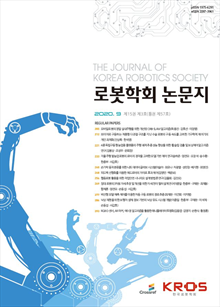간행물
로봇학회논문지 KCI 등재 The Journal of Korea Robotics Society

- 발행기관 한국로봇학회
- 자료유형 학술지
- 간기 계간
- ISSN 1975-6291 (Print)2287-3961 (Online)
- 수록기간 2006 ~ 2020
- 주제분류 공학 > 제어계측공학 공학 분류의 다른 간행물
- 십진분류KDC 559DDC 629
권호리스트/논문검색
제9권 제2호 (통권 제32호) (2014년 5월) 6건
1.
2014.05
서비스 종료(열람 제한)
We are at the dawn of a new era in which the importance of robots will be evaluated on the basis of not only their functions but also their appearance. Therefore, those manufacturers who continue to develop robots that only offer convenience and do not keep up with the emerging trends might be weeded out from the robot market in the future. This study empirically tested and verified the ways in which the commercial value of wearable robots is enhanced when they are stylishly attired, using user and work environment analysis. For the purpose of this study, a styling development project for wearable robots was undertaken and applied to the actual development of these robots. Based on the results of the study, a new styling process for such robots was established. Those manufacturers who will realize the importance of styling of robots and develop robots using this process shall become the trendsetters in designing stylized robots and lead the robot industry in the future.
2.
2014.05
서비스 종료(열람 제한)
Global localization is one of the essential issues for mobile robot navigation. In this study, an indoor global localization method is proposed which uses a Kinect sensor and a monocular upward-looking camera. The proposed method generates an environment map which consists of a grid map, a ceiling feature map from the upward-looking camera, and a spatial feature map obtained from the Kinect sensor. The method selects robot pose candidates using the spatial feature map and updates sample poses by particle filter based on the grid map. Localization success is determined by calculating the matching error from the ceiling feature map. In various experiments, the proposed method achieved a position accuracy of 0.12m and a position update speed of 10.4s, which is robust enough for real-world applications.
3.
2014.05
서비스 종료(열람 제한)
Mapping is a fundamental element for robotic services. There are available many types of map data representation such as grid map, metric map, topology map, etc. As more robots are deployed for services, more chances of exchanging map data among the robots emerge and standardization of map data representation (MDR) becomes more valuable. Currently, activities in developing MDR standard are underway in IEEE Robotics and Automation Society. The MDR standard is for a common representation and encoding of the two-dimensional map data used for navigation by mobile robots. The standard focuses on interchange of map data among components and systems, particularly those that may be supplied by different vendors. This paper aims to introduce MDR standard and its application to map merging. We have applied the basic structure of the MDR standard to a grid map and Voronoi graph as a kind of topology map and performed map merging between two different maps. Simulation results show that the proposed MDR is suitable for map data exchange among robots.
4.
2014.05
서비스 종료(열람 제한)
Human-robot co-operation becomes increasingly frequent due to the widespread use of service robots. However, during such co-operation, robots have a high chance of colliding with humans, which may result in serious injury. Thus, many solutions were proposed to ensure collision safety, and among them, collision detection algorithms are regarded as one of the most practical solutions. They allow a robot to quickly detect a collision so that the robot can perform a proper reaction to minimize the impact. However, conventional collision detection algorithms required the precise model of a robot, which is difficult to obtain and is subjected to change. Also, expensive sensors, such as torque sensors, are often required. In this study, we propose a novel collision detection algorithm which only requires motor encoders. It detects collisions by monitoring the high-pass filtered version of the velocity error. The proposed algorithm can be easily implemented to any robots, and its performance was verified through various tests.
5.
2014.05
서비스 종료(열람 제한)
Localization is one of the essential tasks necessary to achieve autonomous navigation of a mobile robot. One such localization technique, Monte Carlo Localization (MCL) is often applied to a digital surface model. However, there are differences between range data from laser rangefinders and the data predicted using a map. In this study, commonly observed from air and ground (COAG) features and candidate selection based on the shape of sensor data are incorporated to improve localization accuracy. COAG features are used to classify points consistent with both the range sensor data and the predicted data, and the sample candidates are classified according to their shape constructed from sensor data. Comparisons of local tracking and global localization accuracy show the improved accuracy of the proposed method over conventional methods.
6.
2014.05
서비스 종료(열람 제한)
The robot mechanisms that were previously researched had only been conducted for the purpose of overcoming the obstacles stably at low speed driving and enhancing the stability against high speed circuitous driving, and yet, the mechanism satisfying two purposes. However, in order to stably drive with high speed on rough terrain, there is a need for satisfying both of these purposes, as well as testing the efficiency of the mechanisms at high speed driving. There, this paper simulated some of the passive mechanisms and focused on checking the performances of passive mechanisms through simulations and analyzing each mechanism on the basis of an evaluation index. The simulation was conducted by Adams (The Multi-body Dynamics Simulation Solution) and used various types of passive mechanisms which were introduced in the robotics field. As a result, the study confirmed that passive mechanisms have a number of situations that affect the driving stability on each direction of roll and pitch. Further study is needed about active mechanism.

